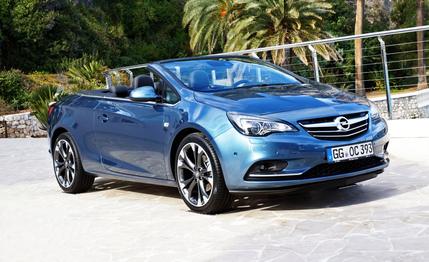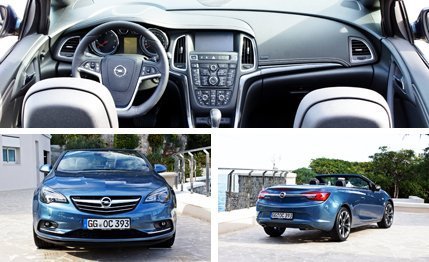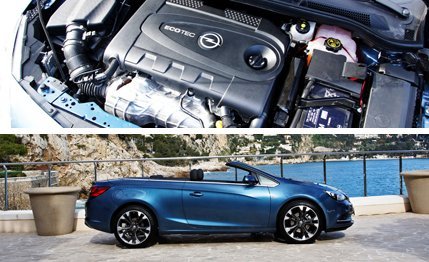
 First Drive Review
First Drive Review
Once upon a time—pre-1980, to be more specific—Opel was a brand with an image roughly on par with Audi. Then Ferdinand Piëch appeared and engineered Audi's inexorable rise to its current prominence, while Opel plodded along under changing leadership until it declined to the point of nearly being sold off or even shuttered altogether.
Thankfully for the GM-owned brand, there have been signs of a recovery. One such indicator is this Cascada, a handsome fabric-roofed convertible largely based on the compact Opel Astra. For its part, Opel is wasting no time in promoting its promise, boldly insisting that its Cascada is an honest competitor to the likes of the Audi A5, the BMW 4-series, and even the Mercedes-Benz E-class cabriolet. But is it? We drove the Cascada to find out.
From Humble Roots
The Opel Cascada starts out with an inherent disadvantage—its platform. The BMW and the Benz, of course, stand on rear-wheel-drive architecture, and the Audi A5 is spun off Audi's medium-to-large MLB modular-longitudinal architecture. The Cascada, by contrast, is built on GM's Global Delta platform and thus shares its underpinnings with more pedestrian vehicles that include the Chevrolet Cruze and the Buick Verano.
From that starting point, GM's Rüsselsheim-based engineering team stiffened the Cascada’s structure with a V-shaped underbody brace, resulting in torsional rigidity far superior to that of the Opel Astra cabriolet, the Cascada's immediate predecessor. But this stiffness comes at a price: The 1.6-liter gas turbo version we drove tips the scales at an estimated 3850 pounds, and the diesel actually comes in at more than 4000.


We prefer the Opel’s more-traditional fabric top to a retractable hardtop; it doesn't just look better, it also leaves more trunk space and is lighter. Two variations are offered—a standard top and a premium top with an additional acoustic layer—but both feature a glass rear window with defroster. We will confirm Opel's claims that the vehicle is as quiet as a coupe, and the roof can be opened or closed by remote control and at speeds up to 30 mph. The Cascada is indeed an all-season vehicle, and a well-packaged one, with a rear seat that’s sufficiently roomy for two.
Helping it battle the traditional luxury brands, exemplary workmanship is one of the Cascada's high points. Higher-priced versions feature beautiful leather, as well as real stitching atop the dashboard. And in typical European fashion, where customers take delight in factory-ordering a vehicle to their individual taste, the options list is long, and encompasses such premium features as ventilated seats. But the dashboard will look familiar to anyone who has recently driven a GM vehicle, down to the three-spoke steering wheel whose sporty style is pretty much nullified by its sheer size.
Power Vacuum
But that’s OK, because the Cascada isn’t sporty. The droptop Opel’s suspension delivers what you’d expect from a nose-heavy front-driver (think Nissan Altima) and the steering, while linear in its response, conveys minimal road feedback. Compared to the VW Eos, not to mention the aforementioned premium convertibles, the driving experience feels languid and lusterless, lacking crispness and enthusiasm. Reaching the limits of the chassis is difficult anyway, given the lack of punch provided by the diminutive 1.6-liter turbo four.


Rated at 168 horsepower and 192 lb-ft of torque (207 lb-ft in overboost mode), it’s said to propel a six-speed-manual Cascada to 62 mph in a lazy 9.6 seconds. (We figure we could achieve a 9.5-second 0–60 time, for what it’s worth.) Top speed is an ungoverned 138 mph. On the plus side, no rush of power at the top end of the tach means there’s no turbo lag to speak of. The driver needs to maintain momentum just to keep up with traffic, keeping revs in the range from 1650–3200 rpm where max torque is generated. The six-speed manual is pleasantly light, but most customers are likely to opt for the six-speed automatic, which is even pokier.
Somewhat surprisingly, there are even less powerful engines in the lineup, including two variations of a 1.4-liter turbo four with 118 or 138 horsepower. The Cascada's top-of-the-line engine will be a 197-hp, 1.6-liter turbo, but for now performance-minded buyers are forced to turn to diesels. Opel offers a 2.0-liter turbo-diesel with 163 or 192 horsepower and 218 or 258 lb-ft of torque.
When Better Buicks Are Built, Opel Will Build Them
One addition could change the Cascada's character: A truly powerful, top-of-the-line engine such as the 2.0-liter turbo that makes 250 horsepower in the top-of-the-line Verano Turbo and 276 horsepower in the Opel Astra OPC. Why do we care? Because the Cascada could—and should—be offered in the U.S. market in Buick form. The alignment between the Opel and Buick brands is high on the list of GM's priorities. Mark Adams, chief designer for both brands, says that he could "imagine the Cascada as a Buick." We agree, as it looks good, it’s roomy, and the quality is right—it just needs the right powertrain. Now, the Cascada won't turn Opel—or Buick—into an Audi competitor, but it is a significant step in the right direction.